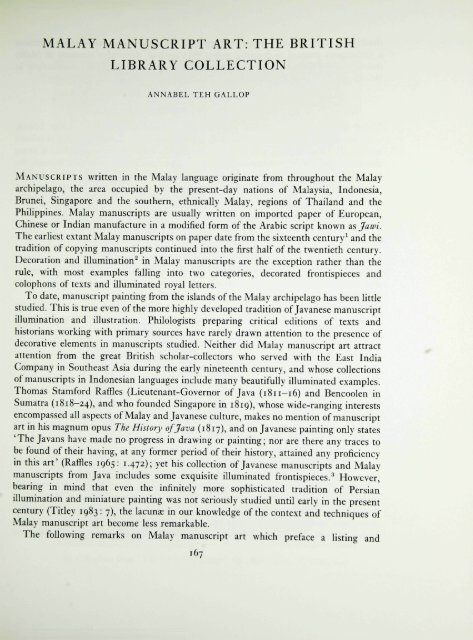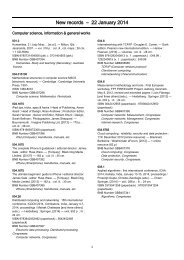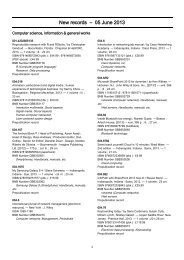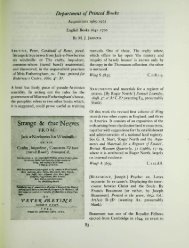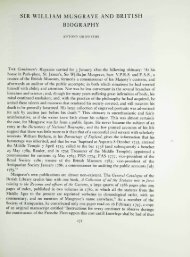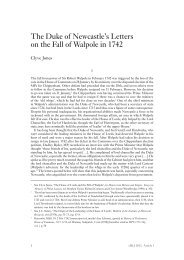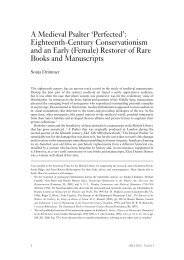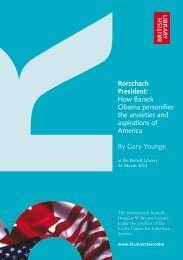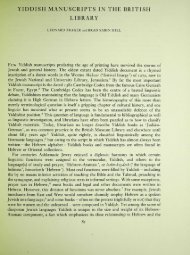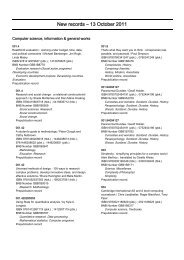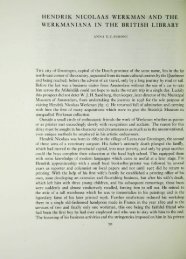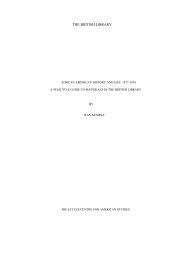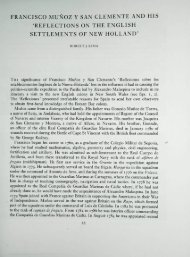MALAY MANUSCRIPT ART: THE BRITISH LIBRARY COLLECTION
MALAY MANUSCRIPT ART: THE BRITISH LIBRARY COLLECTION
MALAY MANUSCRIPT ART: THE BRITISH LIBRARY COLLECTION
Create successful ePaper yourself
Turn your PDF publications into a flip-book with our unique Google optimized e-Paper software.
<strong>MALAY</strong> <strong>MANUSCRIPT</strong> <strong>ART</strong>: <strong>THE</strong> <strong>BRITISH</strong><br />
<strong>LIBRARY</strong> <strong>COLLECTION</strong><br />
ANNABEL TEH GALLOP<br />
<strong>MANUSCRIPT</strong>S wntten in the Malay language originate from throughout the Malay<br />
archipelago, the area occupied by the present-day nations of Malaysia, Indonesia,<br />
Brunei, Singapore and the southern, ethnically Malay, regions of Thailand and the<br />
Philippines. Malay manuscripts are usually written on imported paper of European,<br />
Chinese or Indian manufacture in a modified form of the Arabic script known as Jawi.<br />
The earliest extant Malay manuscripts on paper date from the sixteenth century^ and the<br />
tradition of copying manuscripts continued into the first half of the twentieth century.<br />
Decoration and illumination" in Malay manuscripts are the exception rather than the<br />
rule, with most examples falling into two categories, decorated frontispieces and<br />
colophons of texts and illuminated royal letters.<br />
To date, manuscript painting from the islands of the Malay archipelago has been little<br />
studied. This is true even of the more highly developed tradition of Javanese manuscript<br />
illumination and illustration. Philologists preparing critical editions of texts and<br />
historians working with primary sources have rarely drawn attention to the presence of<br />
decorative elements in manuscripts studied. Neither did Malay manuscript art attract<br />
attention from the great British scholar-collectors who served with the East India<br />
Company in Southeast Asia during the early nineteenth century, and whose collections<br />
of manuscripts in Indonesian languages include many beautifully illuminated examples.<br />
Thomas Stamford Raffles (Lieutenant-Governor of Java (1811-16) and Bencoolen in<br />
Sumatra (1818-24), and who founded Singapore in 1819), whose wide-ranging interests<br />
encompassed all aspects of Malay and Javanese culture, makes no mention of manuscript<br />
art in his magnum opus The History of Java (1817), and on Javanese painting only states<br />
'The Javans have made no progress in drawing or painting; nor are there any traces to<br />
be found of their having, at any former period of their history, attained any proficiency<br />
in this art' (Raffles 1965: 1.472); yet his collection of Javanese manuscripts and Malay<br />
manuscripts from Java includes some exquisite illuminated frontispieces.^ However,<br />
bearing in mind that even the infinitely more sophisticated tradition of Persian<br />
illumination and miniature painting was not seriously studied until early in the present<br />
century (Titley 1983: 7), the lacunae in our knowledge of the context and techniques of<br />
Malay manuscript art become less remarkable.<br />
The following remarks on Malay manuscript art which preface a listing and<br />
167
description of the British Library's collection of decorated Malay manuscripts represent<br />
a preliminary attempt to describe, rather than analyse, decorative elements in Malay<br />
manuscripts. They are based on an examination of decorated Malay manuscripts in<br />
British collections'* and a select study of manuscripts in Malaysian institutions.^<br />
<strong>THE</strong> <strong>ART</strong> OF <strong>THE</strong> <strong>MALAY</strong> BOOK<br />
Malay book art is immediately recognizable as evolving from the broader Islamic<br />
tradition of book illumination, albeit with a distinctive Malay flavour in terms of colours<br />
and motifs. In accordance with the orthodox Islamic aversion to the depiction of living<br />
creatures, figurative representation in Malay manuscripts is extremely rare. Instead, the<br />
artistic energies of Malay manuscript scribes and illuminators were channelled into the<br />
creation of purely decorative frontispieces and colophons, which are found in most<br />
genres of texts, ranging from literature, history, moral and didactic works, and Islamic<br />
texts, including of course, the Koran. Herein lies one obstacle to the systematic study of<br />
Malay manuscript illumination: it might be expected that in the Malay world, as in other<br />
Islamic civilizations, the art of manuscript illumination would reach its apogee in the<br />
Koran. The Koran, however, is only written in Arabic; as such Korans are not,<br />
linguistically speaking, 'Malay' manuscripts. Furthermore, most Western library<br />
collections are arranged and catalogued according to language, and hence it is possible<br />
that in large British collections of Arabic manuscripts there are illuminated Korans from<br />
the Malay world which have not yet been identified as such.^<br />
Characteristic designs for a frontispiece show a text block enclosed within rectangular<br />
borders which may be further surrounded on one, two, three or all four sides by a<br />
combination of single or multiple arches, ranging in shape from simple triangles, ogee<br />
arches and semicircular domes to ornate embellished variations on all three shapes,<br />
sometimes with decorated finials projecting into the page. These arches are often flanked<br />
on either side by pillars representing the projection of the borders of the text block into<br />
the page. Most frontispieces consist of double symmetrical designs, covering two facing<br />
initial pages, and in the majority of cases either the three outer sides of the text block are<br />
decorated, or the ornamentation is concentrated in a headpiece at the top of the text<br />
block. However, single decorated frontispieces are not uncommon, including the earliest<br />
example of Malay book illumination to be dated with any certainty - the initial page of<br />
the Hikayat Seri Rama (MS Laud Or. 291) donated to the Bodleian Library in 1633 by<br />
Archbishop Laud and hence written prior to that date. Colours used here are white,<br />
yellow, dark green and an orange colouring probably produced by the application of<br />
silver on a background of red lead, which has hastened the oxidization process.^<br />
Within the borders and arches of the frontispieces are found arabesques, geometric<br />
patterns and foliate and floral motifs. Indigenous vegetable motifs such as the clove<br />
flower,^ lotus flower (usually presented in its side view), mangosteen calyx and bamboo<br />
shoot, very often linked in a foliate and floral meander pattern, are common to other<br />
Malay decorative arts such as wood-carving, silver-work and embroidery.^ The most<br />
168
PLATE I<br />
a) Frontispiece from 'The Crown of Kings', copied by Muhammad Umar bin<br />
Syaikh Farid in Penang in 1824. Or. MS. 13295, ff. iv, 2r<br />
b) Colophon from 'The Crown of Kings'. Or. MS. 13295, ff, 190V,
PLATE II<br />
Letter from Sultan Mahmud Syah of Johore and Pahang to Thomas Stamford Raffles, 1811.<br />
MSS Eur F 148/4, f
7^ s^^i^^^pr^r^J^}^<br />
^^^<br />
^<br />
' . ><br />
PLATE III<br />
Letter from Sultan Syarif Kasim of Pontianak to T. S. Raffles, i8ii. MSS Eur D 742/1, f.
PLATE IV<br />
a) Frontispiece from the Hikayat Isma Yatim, late eighteenth to early nineteenth century,<br />
Add. MS. 12379, ff- IV' 2r<br />
^<br />
- ! ' ' ^ ' - ' ' ^ - - ^ - ' • ^ ' • ^ • ' • ' ^<br />
b) Frontispiece from the Hikayat Nabi Yusuf, probably eighteenth century,<br />
Malay. D. 4, ff, 3V, 41-
prominent colours are various shades of red and reddish-brown used together with black<br />
and brown, followed by yellow, oehre, green and blue.^" Gold is used both in powdered<br />
form and as gold leaf. Little is yet known about the composition of the inks and pigments<br />
used in the decoration of Malay manuscripts, and whether these are mainly mineral- or<br />
vegetable-based, but later use of watercolours can be attributed to European influence.<br />
Similarly, almost nothing is known about the brushes and other implements used.<br />
Although initial pages account for the majority of instances of manuscript art,<br />
colophons are quite often decorated too. Most colophons in Malay manuscripts are<br />
triangular in shape, the length of the sentences decreasing towards the bottom of the<br />
page. In illuminated examples, decorative motifs usually surround the v-shape, although<br />
in some manuscripts, the decoration may be double-paged and as substantive as the<br />
frontispiece. In a lavishly illuminated text such as the Royal Asiatic Society manuscript<br />
0^ Daftar Sejarah Cirebon (Raffles Malay 30), as well as a richly illuminated frontispiece<br />
and colophon, section headings are set within decorative panels with gold and<br />
polychrome floral ornamentation, in the manner of illuminated Koranic surah headings.<br />
Malay metrical works provide their own opportunities for decoration. There are two<br />
main genres of Malay poetry: syair^ commonly used for narrative epics, and pantun^<br />
quatrains with an a-b-a-b rhyme pattern, with an initial allegorical couplet, the meaning<br />
of which is usually clarified and elaborated in the final couplet. The stanzas of the syair<br />
are also four-lined, with the rhyme scheme a-a-a-a. For both syair and paniun, the<br />
arrangement of the lines of the verses on the written page is nearly always (read from<br />
right to left):<br />
line 2 line i<br />
line 4 line 3<br />
Thus the page is usually divided into two columns, and in illuminated manuscripts the<br />
central divider may be a decorated and coloured vertical border. Alternatively, the<br />
divisions between lines i and 2 and lines 3 and 4 may be marked with coloured<br />
medallions. Sometimes single red or yellow circles^^ are used, but also common are<br />
rosettes made of five, six or even seven superimposed roundels, the resulting 'petals'<br />
carefully coloured in different hues.^^ An interesting illuminated frontispiece and<br />
colophon are found in the Bodleian's Syair Berang-Berang (MS MaIay.e.2(R)) which is<br />
written on pieces of paper stitched and pasted together to form a scroll, a highly unusual<br />
format for a Malay manuscript.<br />
Apart from illuminated frontispieces, colophons and chapter headings, a very specific<br />
type of illumination, inherited from the Middle Eastern tradition, is sometimes found in<br />
a certain category of Malay Islamic works: stylized representations of the symbols of the<br />
holy cities of Mecca and Medina. These are commonly found in Kitab Maulid<br />
manuscripts^^ about the life of the Prophet, and the popular Arabic prayer book DaWil<br />
al-khayrdt}'^<br />
169
ILLUSTRATION<br />
It is perhaps not surprising to find that the one genre of Malay manuscripts which most<br />
often contains depictions of living creatures is that category of subject matter most rooted<br />
in traditional animistic beliefs: divination manuals and collections of charms, mantras<br />
and spells. These are routinely filled with magical sketches and diagrams of animals (real<br />
and imagined), spirits and ghosts. ^^ Sometimes these manuscripts are small enough to<br />
be carried on the person as an amulet, while others, as was the case with all kinds of texts,<br />
might have been written down at the behest of a European as an introduction to the<br />
inhabitants of the Malay spirit pantheon.<br />
Another category of illustrated works includes instruction manuals and subject guides.<br />
These include treatises on court regalia,^*^ guns^' and other weapons like keris (Malay<br />
daggers). One unusual manuscript of recent origin is a manual to the dances of the<br />
Trengganu court, compiled by Tengku Ampuan Mariam, a Princess from Pahang and<br />
consort of Sultan Sulaiman Badrul Alam Syah of Trengganu (r. 1920-1942). Joget<br />
Gamelan fills three lined exercise books, and contains illustrations of dancers showing<br />
details of costumes, hand and feet movements (Harun & Siti 1986). A number of<br />
illustrated manuscripts of narrative works are known to exist, including one from Batavia<br />
dating from the turn of the century. ^^ A small but distinct collection of early twentieth<br />
century illustrated manuscripts is held in the Library of the University of Malaya. ^^<br />
ROYAL LETTERS<br />
Some of the most beautiful examples of Malay manuscript illumination are royal letters.<br />
A royal Malay letter was a complex document, for apart from the actual content of the<br />
letter, the position and wording of the various formal components, each of which offered<br />
scope for artistic embellishments, were determined by the relative status of sender and<br />
recipient, and these considerations in turn affected the aesthetic composition of the<br />
letter.^** At the top of the sheet was a formulaic letter heading in Arabic, often written<br />
in an ornamental calligraphic script. The text block was usually situated asymmetrically<br />
in the lower left corner of the sheet of paper, and when the scribe ran out of space the<br />
text would be continued, upside down and diagonally along the right-hand margin. In<br />
this margin, usually parallel with the opening sentence, would be placed the sender's<br />
seal. Traditional Malay seals were impressed with lamp-black; as this could be very<br />
messy a small flap of paper was sometimes attached to cover the seal, and in some rare<br />
examples the ffap was cut into fancy shapes like a small paper doily.^^<br />
Not all royal letters were illuminated; it is apparent that some kingdoms - such as<br />
Pontianak on the west coast of Kalimantan (Indonesian Borneo), the Riau archipelago to<br />
the south of Singapore, Palembang in Sumatra and the principalities of Madura -<br />
displayed a more artistic bent than others. The most sumptuous of all royal Malay letters<br />
in British collections is also the earliest: a letter of reply from Sultan Iskandar Muda of<br />
Aceh, on the northern tip of Sumatra, to King James I, dated 1615 and given to the<br />
170
Bodleian Library in 1635 by Archbishop Laud (MS Laud Or. Rolls b.i). Nearly a metre<br />
high, the letter is written in a neat and clear hand in black ink on paper sprinkled with<br />
gold, surrounded by a splendidly illuminated floral border with a rich blue dome-shaped<br />
unwdn at the top. It is difl^icult to ascertain the chronological importance of this unique<br />
and splendid epistle within the context of the development of Malay manuscript art, for<br />
the next known illuminated Malay letter from an Asian ruler in a British collection dates<br />
from almost two centuries later. ^^<br />
A fundamental difference of degree can be discerned between Malay book decoration<br />
and the art of royal Malay letters. In Malay manuscript books, examples of decoration<br />
range from simple text borders ruled in red and black, through slightly more elaborate<br />
borders fifled with floral arabesque patterns, to fully ornamented polychrome<br />
frontispieces, the finest of which are embellished with gold. In contrast, the only Malay<br />
letters which were decorated were the very grandest royal letters exchanged between<br />
rulers or with European dignitaries, and hence royal letters were either illuminated<br />
lavishly or not at all. Gold is found in all the decorated letters seen, and is often used<br />
alone. Silver is only rarely found, probably due to its tendency to tarnish. Motifs and<br />
patterns are similar to those found in Malay book decoration, with a preponderance of<br />
floral and foliate meander patterns, arabesques and repeated geometric designs, usually<br />
surrounding the text block but sometimes scattered all over the sheet. Some regular,<br />
repeated, designs appear to have been stencilled or stamped, while a close inspection<br />
reveals that others were painted over a design drawn in pencil or black ink.<br />
Decorative aspects of Malay letters were not just confined to the illumination of the<br />
paper, but extended to the envelopes as well. While ordinary Malay letters were just<br />
folded and sealed, royal letters were often conveyed wrapped in yellow silken envelopes<br />
- yellow being the royal colour - with the address written on a paper wrapper. The paper<br />
address wrapper was sometimes glued or sealed at the join, but in a number of examples,<br />
the two edges were cut into an elaborate pattern which could be interlocked to hold the<br />
wrapper together (see fig. 7).^^ Very few original Malay envelopes have survived, but two<br />
of the earliest Malay letters in British collections still have their envelopes; the letter<br />
from the Sultan of Aceh to King James I mentioned above is stored together with its silk<br />
envelope in the royal colour of yellow (now brown with age) as befitted a letter from one<br />
king to another, while an earlier letter from Sultan Alauddin Syah of Aceh to Sir Harry<br />
Middleton written circa 1602 authorizing him to trade in Aceh (Bodleian Library, MS<br />
Douce Or. e.4) has an envelope of dark green silk. While some of these silks may have<br />
originated from India or China, European silk damasks also appear to have been used<br />
during the late eighteenth and early nineteenth centuries. This tradition continued into<br />
the twentieth century: three letters of welcome presented to Sir Frederick James on a<br />
visit to Brunei in 1919 are also enclosed in silk envelopes (BL, OIOC, Or. MS. 13143).<br />
As might be expected, most of the illuminated Malay letters held in British collections<br />
were sent from local rulers throughout the Malay archipelago to British and other<br />
European officials, but a few surviving examples show that European dignitaries writing<br />
in Malay to local rulers also sent illuminated letters.'^* Both primary and secondary<br />
171
evidence indicate that such letters were usually written on 'ready-illuminated' sheets of<br />
paper. One such example in the British Library collections, a letter from the Dutch<br />
Governor-General Reynier de Klerk in Batavia to Sultan Muhammad Bahauddin of<br />
Palembang in 1780, is written on paper of oriental manufacture of the type made from<br />
jute fibres, which together with the style of the floral decorations indicates an Indian<br />
origin,'^^ It is possible that this is the type of paper referred to when the Dutch Governor<br />
of the North-East coast of Java reported in 1808 that Javanese rulers often asked for goldrimmed<br />
Surat paper from western India for important ofl[icial decrees (Carey 1980: 2).<br />
Secondary sources suggest that when Raffles opened correspondence with Malay rulers<br />
concerning the impending British invasion of Java, he used ready-decorated sheets,<br />
rather than employing local scribes to decorate his letters. Munsyi Abdullah, Raffles's<br />
Malay teacher and scribe, states that when Raffles arrived in Melaka (formerly known as<br />
Malacca) in late 1810 he brought with him 'paper for writing letters to Malay rulers and<br />
princes with gold and silver headings, and many other objects intended as presents for<br />
Malay royalty''^^ (Hill 1970: 74).<br />
DECORATED <strong>MALAY</strong> <strong>MANUSCRIPT</strong>S IN <strong>THE</strong> <strong>BRITISH</strong> <strong>LIBRARY</strong><br />
Most of the manuscripts listed here derive from the collections of Thomas Stamford<br />
Raffles (1781-1826), John Crawfurd (1783-1868) and John Leyden (1775-1811), who all<br />
served in Southeast Asia during the first quarter of the nineteenth century. The<br />
manuscripts themselves also mostly date from this brief period. The eleven codices are of<br />
very variable artistic quality: they include one of the finest illuminated Malay<br />
manuscripts known, the Tdj al-Saldtln (Or. MS. 13295)7 copied in Penang in 1824, while<br />
most of the others could be termed more ' rustic' examples of manuscript decoration. On<br />
the other hand, the collection of illuminated Malay letters in the British Library is the<br />
best in the country, and many of these were recently displayed publicly for the first time<br />
in the British Library exhibition Paper and Gold (Gallop 1990). Nine of the ten letters<br />
listed below were sent to T. S. Raffles between the years 1811 and 1816.<br />
All the decorated and illuminated Malay codices and letters in the British Library<br />
described below are held in the Oriental and India Office Collections unless indicated<br />
otherwise. Personal names of Malays and names of the Islamic months are given<br />
according to the Revised [Malaysian/Indonesian] Orthography of 1972 and the Kamus<br />
Besar Bahasa Indonesia (Jakarta, 1988). The order of information given in the<br />
bibliographic descriptions is as follows: Manuscript number; title or description; date<br />
and name of author/copyist if known; number of folios if greater than one; writing<br />
materials, and names and dates on watermarks if any; size of folio; provenance; RV<br />
(Ricklefs and Voorhoeve) catalogue reference. Beginning and end of text (for codices).<br />
Description of decorative elements.<br />
172
Add. MS. 12379. Hikayat Isma Yatim<br />
Codices<br />
Probably copied late i8th-early 19th century; 97 f.; ink, gold, red, blue-grey and black on<br />
European paper, no discernible watermark; 34x23 cm.; blind-tooled full leather binding;<br />
Crawfurd collection, 1842; RV (1977: 107-8), Lee (1989: Plate i). Text begins: (f. iv) Al-kisah<br />
im htkayat Bahari Kala di tanah Melayuyang amat indah2 karangannya ...\ ends abruptly (f 97r)<br />
...negeri terlalu ramai segala bunyi-bunyian tiada sangka.<br />
ff. iv-2r. Double frontispiece; 12 lines of text within thin blue vertical and red<br />
horizontal borders. Above and below the text block are rectangular panels of gold leaf<br />
surrounded by a repeated red-blue triangular pattern. The vertical columns bordering<br />
the text project into the page and are fifled with a red and white floral arabesque pattern<br />
against a blue background. On the three outer sides the borders are surmounted by<br />
triangles containing a gold floral pattern with red details against a blue background with<br />
thin red and black borders. Red floral finials project into the page from the three outer<br />
sides (pi, 4a).<br />
Although the overall visual impression of this frontispiece is striking, with bold use of<br />
gold, the illumination has been executed without particular care. The pattern appears to<br />
have been drawn directly with pen and ink, as there is no trace of pencil markings. In<br />
many cases pigment has extended beyond its intended borders. Within the three<br />
triangular sections on each of the two pages of the frontispiece, gold appears to have been<br />
applied first to the whole triangle. Blue pigment was then applied on top of the gold, and<br />
finally the floral arabesque patterns outlined in black ink on top of the remaining gold.<br />
This is one of only two Malay manuscript books in the British Library illuminated<br />
with gold (the other being Or. MS. 13295 below). It was probably created in court circles<br />
as on f. ir is a list of English letters with the statement in Malay that 'Raja Ahmad' wrote<br />
them.<br />
Add. MS. 12386. Hikayat Perintah Negeri Benggala<br />
Composed by Ahmad Rijaluddin in Ramadan 1226 (Sept. 1811); 51 f.; pencil, black and brown<br />
ink on European paper; 31x19 cm.; half leather binding with marbled boards; Crawfurd<br />
collection, 1842; RV (1977: 108, 1982: 319). Text begins: (f. iv) Imlah hikayat diceterakan<br />
perintah negeri Benggala tatkala masa zaman senda Ahmad Rijaluddin ibn Hakim Long Fakir<br />
Kandu belayar (f. 2r) memawang diri ke Benggala maka dikarang hikayat ini menanggal akan zaman<br />
diperbuat surat pada sanat 1226 thahun2 dal awal pada bulan Ramadan; ends: (f 49V)<br />
,.. demikianlah diceterakan oleh orang yang empunya cetera itu.<br />
ff. iv-2r. Double frontispiece; 6 lines of text within square double ruled borders,<br />
surrounded on three outer sides with bold floral patterns in brown ink over pencil<br />
outline. Two different inks are used in this manuscript: black ink for text on ff. 2V-49V,<br />
and brown ink for ff. iv-2r, 5ov-5ir, double ruled borders and catchwords throughout<br />
manuscript.<br />
173
ff. 5ov-5ir. Double decorated rectangular borders surrounding empty text blocks (text<br />
ends on f 49V). The borders are filled with small four-petalled clove flowers within a<br />
diamond-shaped grid, with large clove flowers at the corners.<br />
Or. MS. 13295. Taj al-Saldttn<br />
Copied by Muhammad Umar bin Syaikh Farid, 4Zulhijah 1239 (31 July 1824); 191 f; ink, gold,<br />
dark blue, light blue, red, maroon, yellow and white on English paper, 'R Barnard 1820';<br />
25 X 18 cm,; gold-tooled red leather Islamic-style binding; acquired in 1970; RV (1977: iio-ii).<br />
Text begins: (f i v) Bismillah al-rahmdn al-rahim a [sic] Tdj al-Saldtin artinya makuta segala rajaraja...;<br />
ends: (f. i9ir) ...tamat al-kalam Tdj al-Saldttn.<br />
ff. iv-2r. Double frontispiece; 9 lines of text in black ink with red rubrics on white<br />
cloud-like panels edged in black against a sea of gold. The text block is enclosed by<br />
various decorative layers, all executed with the greatest finesse and artistry, starting with<br />
two flanking vertical columns each enclosing a distinct gold arabesque pattern, with red,<br />
white and gold flowers in the outer column and purely gold foliage on the inner column,<br />
against a deep blue background flecked with tiny white and red crosses. These tiny<br />
scattered crosses occur throughout the decoration of the initial pages. The columns and<br />
text block are enclosed by two thin borders of red and blue flecked with white. Across<br />
the top and bottom are two panels of gold, these and the text block all enclosed by a<br />
further three thin borders of blue, gold and maroon. The straight lines and borders are<br />
enclosed within a series of undulating wave-like patterns which surround the decorated<br />
text block on the three outer sides, first in gold, then dark blue, and finally yellow, each<br />
band filled with decorative floral motifs edged in gold. Finally, two distinct types of<br />
finials project into the page from the peaks and troughs of the wavy border (pi. ia).<br />
ff. 2v-i9or. On each page, the text blocks are enclosed within 6-ruled borders of<br />
alternating gold and blue.<br />
ff. I9ov-i9ir. Double colophon; 13 lines of text within red and gold borders, flanked to<br />
left and right by two vertical columns containing different gold floral arabesques. At top<br />
and bottom of each text block are panels containing inscriptions which give the name of<br />
scribe and date of writing in Arabic and Persian :^^<br />
f 190V (top): katdbahu al-faqir al-haqir bi-al-dhanb ma-al-taqstr<br />
f. 190V (bottom): mdshd'tkh al-musammd Muhammad Umar bin Syaikh Farid<br />
f. i9ir (top): 'a.fiyO' Allah 'anhumd wa-anjami'' al-Muslimtn amin<br />
f. i9ir (bottom): ba-mdh-i zu al-hajj ba-tdrikh-i chahdrum sanat-i i23g hijrt<br />
These panels and the text blocks are framed by thin maroon borders and enclosed by an<br />
undulating gently arching pattern on the three outer sides, from which numerous finials<br />
project into the page (pL ib).<br />
As mentioned above, this manuscript is one of the most exquisite examples of Malay<br />
manuscript illumination known. However, stylistically it is rather unusual, and could not<br />
be described as a 'typical' Malay design executed to the highest standards, such as, for<br />
174
example, the illuminated copy of the Bustdn al-Saldtin (Raffles Malay 42) in the Library<br />
of the Royal Asiatic Society. The predominance of blue and gold is uncommon for a<br />
Malay manuscript and in fact represents a conscious tendency towards more<br />
'mainstream' Islamic manuscript illumination from India and the Middle East. The<br />
practice of writing the text on bands of white within irregularly undulating edges<br />
surrounded by gold is common in eighteenth and nineteenth century manuscripts from<br />
Persia and India (see, for example. Lings & Safadi 1976: 87).<br />
Or. MS. 14194- Malay and Arabic prayer-book<br />
Various texts in different hands in Malay, Arabic and [Acehnese?]; c. 19th century; 112 f; red,<br />
purple and black ink on Italian paper, 'Antonio Galvari', 3 crescent moons; 168 x 11-5 cm.; red<br />
cloth cover pasted to initial and final folio, wrapped in loose goatskin wrapper with curved flap<br />
(in red ink on inside of flap: Surat Abdullah anak Abdul Rasyid Tanahabu ...)\ from E. J. Brill,<br />
1984.<br />
f. 44V. Single frontispiece; 6 lines of text surrounded by rectangular border containing<br />
scalloped pattern in red, white and black, with more intricate plaited panel across top.<br />
Headpiece of two floriated posts flanking a triangular arch culminating in floral plume.<br />
MSS Malay B.3<br />
B. Syair Silambari<br />
Copied by Ibrahim on 18 Syawal 1225 (i6 November 1810); ff. 2ov-36r; ink, black and red on<br />
English paper, '1796' 'GR' (ff. 20-34), unwatermarked paper made from flax & hemp (ff. 35-6);<br />
20 X 14-5 cm.; John Leyden collection; RV(i977: 123). Text begins: (f 22\) Ada satu silambari /<br />
bunga kembang dini hari /pari bijak siapa rangkat / kita karang satu nyanyi; ends: (f. 36r) sanat<br />
122$ tahun2 wau pada dua lapan belas hari bulan Syawal kepada hart arb'a bahwa pada ketika itu<br />
ditamatkan kitab silambari namanya kisah Ferangki ambil bmi Cina di dalam negeri Melaka jadt<br />
perang besar dengan Wilanda adapun yang empunya surat ini wa-katibuha Ibrahim.<br />
ff. 22V-23r. Double frontispiece; 7 lines of text within ruled black and red borders filled<br />
with black-ink arabesque pattern, consisting of eight lotus flowers at corners and centre<br />
of each side linked by decorated tendrils and foliage. The floral patterns on f. 22v are<br />
larger and slightly more elaborate than those on f. 23r (fig. i).<br />
f. 36r. Colophon; 11 lines, with decorative panels outlined in red and black containing<br />
floral and foliate meander patterns surrounding last 5 v-shaped lines of text.<br />
C. Syair surat kirim kepada peretnpuan<br />
Probably copied at around the same time as B; ff. 36V-45; ink, red, black, blue, green and yellow<br />
in the same hand on same paper (flax & hennp), foho size, provenance and RV reference as B<br />
above. Text begins: (f. 36V) Ini surat kirim kepada perempuan / salam doa daripada kakanda /<br />
175
. Frontispiece from the Syair Silambari, copied by Ibrahim, 1810. MSS Malay B.3(B),<br />
ff.<br />
Fig. 2. Frontispiece from the Syair surat kirim kepada perempuan^ early 19th cent.<br />
MSS Malay B.3(C), ff. 36<br />
176
datang kepada tuan adinda / ayuhai emas manis syahda / telah termazkur di dalam dada\ ends:<br />
(f. 45r): arwah melayang semangat pun hilang / kehendak Allah apa nangkata.<br />
ff- 36v-37r. Double frontispiece; 5 lines surrounded by squarish border containing floral<br />
arabesque. Headpiece of triangular arch containing large lotus flower, topped by large<br />
foliate plumes and flanked by vertical posts. The floral details and colours used differ on<br />
each of the facing pages (flg. 2).<br />
MSS Malay B.6. Hikayat Muhammad Hanafiah<br />
Copied by Muhammad Kasim on 29 Jumadilakhir 1220 (25 August 1805); 158 f.; ink and two<br />
tones of red on Chinese paper; 20 x 14 cm.; full leather binding; John Leyden collection; RV<br />
(1977: 123). Text begins: (f. iv) Bismillah al-rahmdn al-rahim al-hamdulilah rah al-'alamin ini<br />
hikayat Muhammad Hanafah diceterakan orang yang empunya cetera ini sekali peristiwa maka ada<br />
kepada suatu hari rasul Allah pun duduk dalam masjid Medinah dihadap oleh segala sahahat<br />
sekalian...\ ends: (f. \^%Y)...tamat hikayat Muhammad Hanafiah anak cucu hini salallahu ''alaihi<br />
wasalam pada sanat 1220 tahun-tahun wau pada sembilan likur hart bulan Jumadilakhtr pada hart<br />
ithnin Muhammad Kasim.<br />
if. iv-2r. Double frontispiece; 7 lines of text within rectangular borders, the two pages<br />
in diiferent shades of red pigment. The top and bottom panels contain a large lotus<br />
flower with foliage, the vertical side panels contain a meandering foliate pattern, with<br />
large four-petalled flowers at each corner. The apparent simplicity of this design belies<br />
its quintessentially Malay charm (fig. 3).<br />
f. i58r. Colophon; 10 lines of text bordered by a simple and elegant curved v-shape<br />
beginning and ending in a floral flourish, in red ink outlined with black.<br />
MSS Malay B.12. Hikayat Perang Pandawa Jaya<br />
Copied by Muhammad Kasim on 22 Syakban 1219 (26 November 1804); 119 f; ink, red, pink<br />
and black on Chinese paper; 20-5 x 14-5 cm.; unusual {now loose) binding of plaited straw<br />
stitched to a cloth cover of [Indian ?] chintz patterned with red carnations and green foliage; John<br />
Leyden collection; RV (1977: 124-5). Text begins: (f iv) Al-kisah maka tersebutlah perkataan<br />
Arya D-s-t-r-s-t itu seorang saudara Maharaja Pandawa Jaya...; ends: (f 117r) tamat pada sanat<br />
I2ig tahun2 ba pada dua Itkur hari bulan Sya'ban pada hart ithnin Muhammad Kasim; owner's<br />
mark [?] upside down on f ii8r: empunya Tunku p-a-n-?.<br />
ff. iv-2r. Double frontispiece; 7 lines of text surrounded by rectangular borders<br />
containing four-petalled flowers within panels at centre and lotus flowers at corners, with<br />
attendant foliage. Borders project into page on three outer sides, flanking shallow domes<br />
(black at top and bottom, red at side) containing foliate pattern, topped by trefoils.<br />
Substantial floral flnials protrude diagonally from the two outer corners of each page.<br />
While f. 2r uses only black and pink, red is also used in f. iv for the floral flnials and<br />
in the domes. The manuscript was copied by the same scribe as MSS Malay B.6, and<br />
details in the decorative frontispieces are also similar (flg. 4).<br />
177
m<br />
I<br />
H<br />
. J. Frontispiece from the Hikayat Muhammad Hanafiah.^ copied by Muhammad Kasim,<br />
1805. MSS Malay B.6, ff. iv-2r<br />
Fig. 4. Frontispiece from the Htkayat perang Pandawa Jaya, copied by Muhammad Kasim,<br />
1804. MSS Malay B.12, ff. iv-2r<br />
178
MSS Malay B.14. Hikayat Indera Putera<br />
Early 19th century, c. 1821 (Mulyadi 1983: 10); 78 f.; ink, red and black on Chinese paper;<br />
20 X 15 cm.; quarter leather and buckram binding; acquisition uncertain; RV (1977: 125). Text<br />
begins (f iv): Bismillah al-rahmdn al-rahim al-hamdulilah rab al-'alimm wabah nasht'in btllah 'ali<br />
inilah hikayat Inderaputera yang indah2 pekerjaannya dan ialah yang syohor ceriteranya pada<br />
manusyia dan pada tanah jihin yang amat elok rupanya serta kesyaktiannya terlalu amat<br />
pantasnya...; ends abruptly: (f 77r) ...dan empat puluh payung mestt dikarang.<br />
ff. iv,2v. Double frontispiece;^^ 10 lines of text within triple rectangular borders filled<br />
with floral and foliate patterns. Vertical borders project into page at top and bottom,<br />
flanking a semi-circular arch filled with a chequered pattern. Along two vertical sides are<br />
three semi-circular arches, two filled with chequered patterns flanking one filled with<br />
foliage.<br />
MSS Malay C.2. Hikayat Cekel Waneng Pati<br />
Early 19th century; 153 f; ink on Chinese paper; 29 x 22 cm.; full leather binding; John Leyden<br />
collection; RV (1977:125).<br />
flf. (i)v-ir. Crude drawings of flowers and doodles of n^^j/^zw^-style faces in pen and black<br />
ink. On f ir: Cat dari pada adinda Ditpa [d-y-w] datang kepada k-k (page trimmed).<br />
f. 51V. Crude drawing of wayang puppet (face missing due to paper damage) and flowers.<br />
MSS Malay D.3. Hikayat Parang Puting<br />
Copied for T. S. Raffles by Ibrahim on 29 Syawal 1225 (27 November 1810); 63 f; ink, pencil<br />
and reddish-brown pigment on European paper; 30x18 4 cm.; full leather binding; John<br />
Leyden collection; RV (1977: 126). Text begins: (f ir) Inilah cetera orang dahulu kala dtceterakan<br />
oleh orang yang empunya ceteranya hikayat Parang Puting anak dewa laksana dewa dari kayangan<br />
terlalu indah perkataan maka ia berperang dengan naga di dalam laut dengan sabab tuan puteri<br />
hendak diambil oleh naga itu inilah ceteranya...; ends: (f 63V) tamat pada sanat 122s tahun2 wau<br />
pada sembilan likur hari bulan Syawal pada hari thelatha ditamatkan surat hikayat Parang Puting<br />
Tuan Mister Rafles empunya surat ini wa-katibuha Ibrahim.<br />
f. ir. Single frontispiece (unfinished); 9 lines of text surrounded by two rectangular<br />
borders, the inner one filled with four-petalled flowers and the outer one filled with a<br />
foliate meander pattern. Another horizontal border containing a floral and foliate pattern<br />
is placed top and bottom. To the left, an unfinished arching decorative pattern adjoins<br />
the vertical border, with some details outlined in black ink.<br />
MSS Malay D.4. Hikayat Nabi Yusuf<br />
Many names of scribes or owners are found in this manuscript, which has a complicated<br />
colophon, but copying was apparently completed by Muhammad Lebai^^ on 5 Ramadan 1216 (9<br />
179
January 1802); 34 f,; ink, red, black, green and ochre on oriental paper; original paper covers of<br />
one sheet of oriental paper stuck to one sheet of European paper with chain lines, very soiled, with<br />
scribbled notes in Malay and Tamil; English endpapers, 'S. Wise & Patch', '1807 U.E.I.C<br />
[United East India Company]'; 31 x 19-5 cm.; full leather binding; John Leyden collection; RV<br />
(1977: 126). Text begins: (f 3v) Bismillah al-rahmdn al-rahim wabah nasht'in billah 'ali ini peri<br />
mengatakan hikayat Nabi Allah Yusuf...\ ends with many scribblings: (f 3ir) ...tamat al-kalam<br />
bi'l-khairi wa al-salam sanat 1216 tahun kepada 5 hari bulan Ramadan pada hari Ahad...yang<br />
menyura! Hikayat Nabi Allah Yusuf ini dan pada mulanya datang kesudahannya senda Muhammad<br />
Lebai...\ above the double frontispiece: (f 3v) Inilah bekas tangan Ci'' Mat orang k-a-y-a~ng-n<br />
dipinjam oleh Ci' Candra (f. 4r) intlah tulisan Ci' Mat Tok Muda anak Raja Indra PVangsa di Perlis.<br />
ff. 3v-4r. Double frontispiece; 10 lines of text within rectangular borders on three outer<br />
sides, divided by diagonal lines across corners, surmounted by wavy domes at top and<br />
bottom. Densely decorated with lotus flowers and foliate arabesques, intensely and<br />
carefully coloured. Although the basic design is symmetrical over the two facing pages,<br />
many of the decorative floral patterns are different on each of the two pages (pi. 4b).<br />
This is a very unusual pattern, with striking use of strong dark colours. On the basis<br />
of visual similarity and the binding alone, it is possible to link this manuscript with a<br />
copy of the Hikayal Syah Mardan held in the Royal Asiatic Society (Raffles Malay 66)<br />
which also has a double decorated frontispiece in the same colours. The close<br />
relationship of the two manuscripts is proved by the occurrence of the same names of<br />
owners or scribes: Ci' Candra (MSS Malay D.4, f 3V; Raffles Malay 66, f. [ii]r, f [iii]r);<br />
Muhammad Yusuf (MSS Malay D.4, f. 31V; Raffles Malay 66, p. 225).<br />
Letters<br />
Manuscript Collections, Add. MS. 45273, ff. 28v-29r<br />
Farewell letter from Panembahan Nata Kusuma of Sumenep, Madura, to Thomas Stamford<br />
Raffles, 3 Jumadilakhir 1231 (i May 1816). Ink, yellow, ochre, brown, red, pink, green and gold<br />
on English paper, 'Stroud & Co 1806' 'S&N'; red wax seal; 46-5 x 37 cm.; from Mrs Drake,<br />
1939; RV (1977: 44), Gallop & Arps (1991: No. 17).<br />
A strong European influence is apparent in the illumination of this letter. A garland of<br />
roses and leaves with a chain of gold links surrounds the text block, joined at the bottom<br />
with a sheaf of green leaves and gold bow, issuing forth from gilded cornucopia-like<br />
scrolls at the top. The heading is written on a pink medallion framed by green sheaves,<br />
surmounted by a European-style crown in red and gold with a cross at its centre (fig. 5).<br />
A large collection of illuminated letters both from the Panembahan of Sumenep to<br />
Dutch officials and to the Panembahan from European dignitaries, including one letter<br />
from Raffles, are held in the Koninklijk Instituut voor Taal-, Land- en Volkenkunde in<br />
Leiden (Maronier 1967: 136-7).<br />
180
c<br />
s ><br />
•^ CL
MSS Eur D 742/1, f. 31<br />
Letter from Sultan Syarif Kasim ibn Sultan Syarif Abdul Rahman ibn al-Habib al-Husin al-<br />
Kadri of Pontianak, west Kalimantan, to T. S. Raffles, 26 Safar 1226 (22 March 1811). Ink, gold<br />
and silver on English paper, 'Budgen & Wilmott 1807'; lamp-black seal; 40x32-5 cm.; RV<br />
(1977: 122).<br />
The illuminated border is composed of a diamond-shaped pattern enclosing fourpetalled<br />
clove flowers. The sheet is scattered with two varieties of floral clusters: a single<br />
layer of clusters of two flowers and two leaves next to the border, and clusters of four<br />
flowers across the central part of the sheet. Six floral clusters in the middle have stalks<br />
of silver (now tarnished).^** Close inspection indicates that the pattern was first outlined<br />
in black ink, on top of which gold was applied.<br />
MSS Eur D 742/1, f. 32<br />
Letter from Sultan Syarif Kasim of Pontianak toT. S. Raffles, 16 Safar 1226 (12 March 1811). Ink<br />
and gold on English paper, 'Budgen & Wilmott 1807'; lamp-black seal; 40 5x32-5 cm.; RV<br />
(1977: 122).<br />
The illuminated border contains a five-petalled floral and foliate meander pattern with<br />
clove flowers at the corners, while the whole sheet is scattered with gold floral clusters<br />
of three flowers and three leaves on a single stalk (pi. 3).<br />
MSS Eur D 742/1, f. 33a<br />
Letter from Sultan Syarif Kasim of Pontianak to T. S. Raffles, 20 Muharam 1226 (14 February<br />
1811). Ink and gold on English paper,' Budgen & Wilmott 1807'; 78 x 32-5 cm.; lamp-black seal;<br />
RV (1977: 122), Gallop & Arps (1991: No. 9).<br />
Two different floral designs are found on the two sheets which have been pasted together<br />
to form this letter. The top sheet has three flowers and two leaves on a single stalk; the<br />
bottom sheet has three flowers and two leaves on a double stalk. In the centre of the<br />
illuminated border at the top of the top sheet is a four-petalled flower not present in the<br />
centre of the border of the bottom sheet; otherwise the whole border contains a threepetalled<br />
floral and foliate meander pattern with large clove flowers at the corners.<br />
MSS Eur D 742/1, ff. 58-9<br />
Letter from Governor-General Reynier de Klerk and the Council of the Indies in Batavia to<br />
Sultan Muhammad Bahauddin of Palembang, 15 August 1780. 2 f (originally pasted together to<br />
form a long scroll?); ink, glitter and gold on Oriental paper; red wax seal; 48x28-5 &<br />
41 X 28-3 cm.; yellow silk envelope, 36 x 8 cm., with paper address wrapper (f. 60); RV (1977:<br />
122), Gallop & Arps (1991: No. 18).<br />
182
Both the sheets are decorated with a scattered seven-petalled floral design, with<br />
illuminated borders enclosing floral arabesque patterns to the top three sides off. 58 and<br />
the bottom three sides of f. 59.<br />
MSS Eur D 742/1, flf. 71-2<br />
Letter from the Raja of Buleleng, Bali, to T. S. Raffles, i Safar 1226 (25 February 181 r). Ink and<br />
gold on European paper; 45-5 x 31-5 cm.; red wax seal; RV (1977: 122), Gallop & Arps (1991:<br />
No. 8).<br />
The simple illumination found in this letter consists of a border containing a thick wavy<br />
design in gold horizontally across the top and vertically down the right of the text block,<br />
while the letter heading at the top of the sheet, Qawl al-haqq, is enclosed in double wavy<br />
petal-like lines of gold.<br />
MSS Eur E 378/1<br />
Letter from Sultan Syarif Kasim of Pontianak to T. S. Raffles, 15 Safar 1229 (6 February 1814).<br />
Ink and gold on English paper, 'Budgen & Wilmott 1808'; lamp-black seal; 50 x 37 cm.; RV<br />
(1982: 307), Gallop & Arps (1991: No. 10).<br />
The area surrounding the text block is covered with an unusual curved-honeycomb grid<br />
pattern, enclosing a floral motif, with a hint of European influence. The text block is<br />
outlined in gold, and the lines of text in the main body of the letter are separated by ruled<br />
lines of gold.<br />
MSS Eur E 378/7<br />
Farewell letter from Sultan Cakra Adiningrat of Madura to T. S. Raffles, 14 Muharam 1231 (16<br />
December 1816). Ink, gold, light blue and dark blue on English paper, 'i8ro' with seated<br />
Britannia within crowned oval; red wax seal; 32-5 x 20-5 cm.; RV (1982: 307), Gallop & Arps<br />
(1991: No. 15).<br />
The text is enclosed on the top three sides by a gold border containing jasmine flowers<br />
with two golden petals and one blue, and many-petalled gold flowers at the top two<br />
corners and centre. The top third of the sheet is occupied by an elaborate floral pattern<br />
which betrays a European influence in gold and two tones of blue.<br />
MSS Eur F 148/4, f. 105<br />
Letter from Sultan Mahmud Syah of Johor and Pahang to T. S. Raffles, 9 Zulhijah 1225 (5<br />
January 1811). Ink and gold on English paper, 'G. Taylor 1802'; 49 x 38-5 cm.; Raffles-Minto<br />
collection, 1969; Gallop & Arps (1991: No. 12).<br />
183
Fig. 7. Yellow damask silk envelope sent to T. S. Raffles, c. 1824, showing intricately cut-out<br />
interlocking edges of address wrapper. MSS Eur D 742/1, f 61<br />
The text is situated in the lower left part of this geometrically-complex illuminated letter.<br />
The whole sheet is surrounded by three golden borders, the inner and outer borders<br />
enclosing clove-flowers within a diamond pattern and the middle border containing an<br />
elaborate floral pattern. To the top and right of the text block the sheet is filled with a<br />
diamond-shaped grid formed from elaborate s-shapes, enclosing a variety of floral<br />
clusters, with elaborate floral sprays in the two top diagonal corners. The text block itself<br />
is bounded at the top and to the right with a small stepped-diamond pattern within ruled<br />
borders (pi. 2).<br />
MSS Eur F 148/4, f. 106 ^<br />
Letter from Sayid Muhammad Zain ibn al-marhum al-Habib Abdul Rahman al-Kudsi of Lingga<br />
toT. S. Raffles, 10 Zulhijah 1225 (6 January 1811). Ink, gold, red, green, yellow, black on English<br />
paper, 'G.Jones 1807'; 37 5x29 cm.; lamp-black seal, seal flap 5 x 5 cm., oriental paper;<br />
Raffles-Minto collection 1969; Gallop & Arps (1991: No. 13).<br />
The bottom three sides of the sheet of paper are bordered with a gold floral arabesque<br />
within thick red and thin black lines. The text, which is situated to the bottom left of<br />
the page, is bordered to the right by a double-ruled black ink border enclosing gold<br />
flowers with four major and four minor petals and circular red centres, linked by red<br />
stalks with green and yellow leaves. This border extends to the top of the page. At the top<br />
of the text is a beautiful multiple-layered border, with thin black and thick red lines and<br />
a gold four-petalled repeated floral pattern enclosing a thick gold floral arabesque with<br />
gold, blue and black flowers on a rich red background. This border is surmounted by a<br />
mihrab-shaped headpiece, containing a repeated gold cross-shaped grid pattern with red<br />
and black highlights, outlined in red and black and topped by a gold trefoil (fig. 6).<br />
184
APPENDIX: THREE ILLUSTRATED <strong>MALAY</strong> <strong>MANUSCRIPT</strong>S IN <strong>THE</strong> <strong>LIBRARY</strong> OF<br />
<strong>THE</strong> UNIVERSITY OF <strong>MALAY</strong>A, KUALA LUMPUR<br />
As illustrated Malay manuscripts are not common, the opportunity will be taken here to<br />
describe an interesting group of related early twentieth century illustrated manuscripts<br />
held in the Library of the University of Malaya.<br />
MS. 39, Hikayat Dewa Mandu is written in a ledger book with a dark green binding,<br />
250 p, folio size 31-5 x 21 cm. On the title page is written 'Dewa Pandawa' and in blue<br />
crayon underneath 'Hikayat Dewa Pandawa II'. The manuscript is illustrated on 189<br />
out of its 250 pages, sometimes with several scenes per page, in pencil, black ink and<br />
watercolours. Towards the end of the manuscript, the illustrations suddenly become very<br />
colourful with marked use of red, while the black ink text becomes very messy. The<br />
manuscript is dated Ahad 8 Rejab [no year], rumah no. 4, Jalan Pasalin. Two illustrations<br />
from this manuscript are reproduced in Akayet (1989: 3).<br />
MS. 30, Hikayat Hanuman is also written in a ledger book; folio size 335 x 21 cm.<br />
On the title page is written 'Hikayat Hanuman' and in blue crayon 'Hikayat Hanuman<br />
atau Seri Rama IT. The first part of the manuscript consists of 74 p written in black<br />
ink, with many illustrations in bright watercolours, with some use of powdered gold,<br />
including on the initial frontispiece (a different text continues in pencil for a further 39<br />
p). The colophon is found on p. 73: khatam hikayat Sen Rama hijrat ijii [an earlier<br />
date, which might have read ' 1322' with the Arabic figures ' 3' and ' 2' back to front has<br />
been crossed out, and '1311 ?.?' is written across the top] nabi Muhammad r-s-z rasul<br />
Allah kepada 10 hart sabtujam pukul sembilan kepada Dulhijah siang di dalam Kampuang<br />
Kapur di dalam rumah number j p-y-t-s-t-r-p. Sahaya yang puny a tulis empunya Ena' Siti<br />
Mariam bin [sic] End' Sahbudin igo^ [signature: a-w-'-?.^???-Sahbudin]. The language<br />
of the colophon is confused. If the A.H. date was indeed intended to read 10 Zulhijah<br />
1311 (24 June 1894), this might refer to the date of the original manuscript from which<br />
this manuscript was copied; more likely is the reading 10 Zulhijah 1322 which concurs<br />
with the date written above the signature.<br />
MS. 126, Hikayat Indera Mengindera consists of 4 volumes of lined note books,<br />
each 23 X 18 cm., with the following pagination: I (119 p), II (115 p), III (118 p), IV (89<br />
p). Each volume is illustrated throughout. Two colophons are found. Colophon of II, p.<br />
115: terhentilah kepada bulan Jumadilakhir dua puluh lima hari Jumaat jam pukul dua belas<br />
di dalam rumah number dua puluh lima Jalan Pasalian [P~a-s-l-y~a-n]. Sahaya yang<br />
menulis menurun [m-n-u-r-a-n] tauladan orang kepada kepada masa tni sahayalah yang<br />
empunya surat ini tidaklah boleh orang mengikut dia [signature - as in MS. 30]. Colophon<br />
of IV, p. 88: tamat kepada tiga hari bulan Ramadhan r-a-b-kh jam pukul tiga di dalam<br />
rumah Kampung Kapur Jalan Pasyalian rumah number dua puluh lima nyatalah sahaya<br />
k-n din menulis hikayat Indera Mengindera [signature - as above].<br />
Although a lot of information is given in these colophons, some serving to link these<br />
manuscripts with each other, much is presented in a very confusing way, MSS. 30 and<br />
126 are clearly linked by the same signature and the mention of'Kampung Kapur' in<br />
185
the address (although different roads are given), while MS. 39 is linked to these two<br />
manuscripts by the mention of'Jalan Pasalian', which also occurs in MS. 126, although<br />
the house number is given as '4' in MS. 39 and '25' in both colophons of MS. 126. The<br />
tentative conclusion is that MS. 39 was created, if not by the same scribe as MSS. 30<br />
& 126, then within the same circle.<br />
News of a fourth related manuscript has recently emerged: in early 1990, during<br />
preparations for the new Sultan Abu Bakar Museum in Johor, a collection of sixteen<br />
Malay manuscripts came to light. The Malay Manuscripts Centre of the National<br />
Library of Malaysia was invited to document these manuscripts, which remain the<br />
personal property of the Sultan of Johor. One of these manuscripts is a fully illustrated<br />
copy of the Hikayat Muhammad Hanafiah., copied in a ledger book 327 x 21-5 cm., and<br />
dated 27 Rejab 1323 (17 October 1905) at 57 Jl Bas [b-a-s], Kampung Kapur, with a<br />
signature said to be similar to those described above (personal communication from Siti<br />
Mariani Omar of the Malay Manuscripts Centre, National Library of Malaysia,<br />
1.3.1990). The signature, the address in Kampung Kapur, and the date of 1905 would<br />
appear to be strong evidence that this manuscript is related to the three described above.<br />
BIBLIOGRAPHY<br />
Abdul Halim Nasir<br />
1987 Traditional Malay Wood Carving (Kuala Lumpur: Dewan Bahasa dan Pustaka).<br />
Ahmad bin Adam<br />
1971 'A descriptive account of the Malay letters sent to Thomas Stamford Raffles in Malacca<br />
in 1810 and 1811 by the rulers of the indigenous states of the Malay archipelago', M.A.<br />
Thesis, School of Oriental and African Studies, University of London.<br />
Akayet<br />
1989 Akayet Deva Mano: versi Cam de FHikayat Dewa Mandu Malais (Kuala Lumpur:<br />
Kementerian Kebudayaan dan Pelancongan Malaysia; Paris: Ecole Fran^aise d'extremeorient).<br />
Bahan<br />
1982 Bahan-bahan pilthan pameran Arkib Warisan Negara ([Kuala Lumpur]: Arkib Negara<br />
Malaysia).<br />
Blagden, C. Otto<br />
1930 'Two Malay letters from Ternate in the Moluccas, written in 1521 and 1522', Bulletin<br />
of the School of Oriental and African Studies,, VI: 87-101.<br />
Boulger, Demetrius Charles<br />
1897 The Life of Sir Stamford Raffles (London: Horace Marshall).<br />
Braginsky, V. L & Boldyreve, M. A.<br />
1990 'Les manuscrits malais de Leningrad', Archipel., 40: 153-78.<br />
Carey, P. B. R. (ed.)<br />
1980 The Archive of Yogyakarta. Vol. i. Documents Relating to Politics and Internal Court<br />
Affairs (Oxford: published for the British Academy by the Oxford University Press),<br />
(Oriental documents: III).<br />
186
Evans, Ivor H. N.<br />
1929 'Some Malay patterns and designs' & 'Some Malay patterns from Negri Sembilan',<br />
Journal of the F.M.S. Museums, 12: 163-Fig. XXI.<br />
Gallop, Annabel Teh<br />
1990 Paper and Gold: illuminated manuscripts from the Indonesian archipelago. An exhibition in<br />
the British Library ji July to 2j October iggo (London: The British Library).<br />
Gallop, Annabel Teh with Arps, Bernard<br />
1991 Golden Letters: writing traditions of Indonesia (London: The British Library).<br />
Greentree, Richard & Nicholson, Edward Williams Byron<br />
1910 Catalogue of the Malay Manuscripts and Manuscripts Relating to the Malay Language in<br />
the Bodleian Library (Oxford: Clarendon).<br />
Harun Mat Piah & Siti Zainon Ismail<br />
1986 Lambang sari: tari gamelan Terengganu (Bangi: Pejabat Setiausaha Kerajaan Negeri<br />
Terengganu dengan kerjasama Institut Bahasa, Kesusasteraan dan Kebudayaan Melayu,<br />
Universiti Kebangsaan Malaysia).<br />
Hill, A. H. (trans.)<br />
1970 The Hikayat Abdullah [Abdullah bin Abdul Kadir]. (Kuala Lumpur: Oxford University<br />
Press).<br />
Lings, Martin & Safadi, Yasin Hamid<br />
1976 The Qur'dn (London: published for the British Library by the World of Islam<br />
Publishing Company).<br />
Manuskrip<br />
1990 Manuskrip kegemilangan tamadun Melayu: katalog pameran (Kuala Lumpur: Perpustakaan<br />
Negara Malaysia), (Siri bibliografi manuskrip; No. 6).<br />
Maronier, J. H.<br />
1967 Pictures of the Tropics: a catalogue of the drawings^ water-colours^ paintings, and sculptures<br />
in the collection of the Royal Institute of Linguistics and Anthropology in Leiden ('s-<br />
Gravenhage: Martinus Nijhoff).<br />
Lee Geok Boi<br />
1989 Pages from Yesteryear: a look at the printed works of Singapore, i8ig-ig$g (Singapore:<br />
Singapore Heritage Society, 1989).<br />
Mulyadi, S. W. R. (ed.)<br />
1983 Hikayat Indraputra: a Malay romance (Dordrecht: Foris), (Koninklijk Instituut voor<br />
Taal-, Land- en Volkenkunde, Bibliotheca Indonesica; 23).<br />
Raffles, Thomas Stamford<br />
1965 The History of Java. With an introduction by John Bastin, 2 vols. (Kuala Lumpur:<br />
Oxford University Press).<br />
Ricklefs, M. C. & Voorhoeve, P.<br />
1977 Indonesian Manuscripts in Great Britain: a catalogue of manuscripts in Indonesian<br />
languages in British public collections (Oxford: Oxford University Press), (London<br />
Oriental Bibliographies; Vol. 5).<br />
1982 ' Indonesian manuscripts in Great Britain. Addenda et corrigenda', Bulletin of the School<br />
of Oriental and African Studies., 45.2: 300-21.<br />
187
Siti Zainon Ismail<br />
1986 Rekabentuk kraftangan Melayu tradisi (Kuala Lumpur: Dewan Bahasa dan Pustaka)<br />
Titley, Norah M.<br />
1983 Persian Miniature Painting and its Influence on the Art of Turkey and India: the British<br />
Library collection (London: the British Library).<br />
Wilkinson, R. J.<br />
1913 'Notes on Malay letter writing', in R. O. Winstedt, Malay Grammar (Oxford:<br />
Clarendon), pp. 183-205.<br />
1 The oldest Malay manuscript documents known<br />
are two letters from Sultan Abu Hayat of Ternate<br />
to the king of Portugal, written in 1521 and 1522,<br />
and currently held in the Torre do Tombo<br />
archives in Lisbon (Blagden 1930).<br />
2 'Illumination' is used in this article in the strict<br />
sense of the word, i.e. ornamentation in which<br />
metals (gold or silver) are used. 'Decoration', a<br />
broader term which includes 'illumination',<br />
refers to all attempts to beautify the document<br />
through drawings and use of colours.' Illustration'<br />
refers to drawings whose main aim is to clarify<br />
the contents of the text.<br />
3 These include Raffles Malay 30, Raffles Java 4,<br />
Raffles Java 6 and Raffles Java 14, all held in the<br />
Royal Asiatic Society, London.<br />
4 Apart from the British Library manuscripts<br />
listed in this article, decoration was found in the<br />
following Malay codices: Bodleian Library,<br />
Oxford - MS Laud Or. 2gi, MS Malay.e.2(R),<br />
MS Malay c. i, MS Malay.d.i; Cambridge<br />
University Library - Add. 3765, Add. 3767,<br />
Add. 3782, Add. 3791, Or. 642, Or. 846, Or. 851,<br />
Or. 852, Or. 853, Or. 855, Or. 858, Or. 871, Or.<br />
1869; John Rylands University Library of<br />
Manchester - Malay 9; Royal Asiatic Society-<br />
Farquhar 2, Raffles Malay 24, 30, 32, 41, 42, 49,<br />
57, 66, 70, 80, Maxwell 15, 43, 48, 53, Malay<br />
121; School of Oriental and African Studies-<br />
MS 25030, MS 12917, MS 12260, MS 37075,<br />
MS 41516, MS 40322, MS 7124, MS 36496.<br />
The finest collection is that of the Royal Asiatic<br />
Society, while an interesting number of late<br />
nineteenth century examples are held in<br />
Cambridge University Library. Illuminated<br />
letters are held in: Bodleian Library, Oxford-<br />
MS Laud Or. Rolls.b.i; Cambridge University<br />
Library - Or. 637, Or. 638b, Or. 639, Or. 640;<br />
Royal Asiatic Society - Malay 142. Full details<br />
of all these manuscripts can be found in Ricklefs<br />
and Voorhoeve (1977, 1982).<br />
5 I am grateful to the British Council for<br />
supporting a research visit to Malaysia under the<br />
CICHE programme in February-March 1990,<br />
during which time I had the opportunity to<br />
inspect a number of decorated Malay manuscripts.<br />
I would also like to express my thanks for<br />
the assistance of staff at the following institutions<br />
visited: Cik Norzilah and Encik Mat at the<br />
Kelantan Museum; Encik Mohd. Yusof<br />
Abdullah at the Trengganu Museum; Mrs Khoo<br />
Siew Mun and Haji Ibrahim Ismail at the<br />
Library of the University of Malaya; Hj. Wan<br />
Ahmad Hj. Wan Mamat, Encik Samsi Ahmad<br />
and Cik Siti Mariani Omar at the Malay<br />
Manuscripts Centre, National Library of<br />
Malaysia; Puan Rohani Rustam at the Dewan<br />
Bahasa dan Pustaka, and Dr Khoo Joo Ee at the<br />
Museum Seni Asia, Universiti Malaya.<br />
6 The only two Korans in the British Library<br />
which have been positively identified as originating<br />
from island Southeast Asia were acquired<br />
as part of the John Crawfurd collection in 1842.<br />
They can both be presumed to originate from<br />
Java as they are written on dluwang, Javanese<br />
paper made from the beaten bark of the mulberry<br />
tree. One of these manuscripts (Add. MS. 12312)<br />
has an unusual red and black double frontispiece<br />
(Gallop & Arps 1991: No. 70). The other<br />
manuscript is Add. MS. 12343.<br />
7 An identical effect can be seen in the fully<br />
illustrated eighteenth century manuscript of the<br />
story of Damar Wulan., British Library, OIOC,<br />
MSS Jav. 89.<br />
8 What is termed here 'clove flower' more<br />
properly refers to the four-petalled flower-like<br />
shape at the top of the clove.<br />
9 Examples of such patterns can be found in Evans<br />
(1929), Siti Zainon (1986: 260-6) and Abdul<br />
Halim {1987: 81, 88, etc).<br />
10 The prominence of red, used together with<br />
yellow, green and gold, is similar to the colours
found in Maghribi manuscripts from Muslim<br />
North Africa, in contrast to the supremacy of<br />
blue and gold found in the Middle East and<br />
India.<br />
11 See, for example, Syair Silindung Delitna., School<br />
of Oriental and African Studies, MS. 40322, late<br />
i8th-ear!y 19th century.<br />
12 See, for example, Pantun alifba ta., Royal Asiatic<br />
Society, Maxwell 48, 1879.<br />
13 A particularly fine example is Kelantan Museum<br />
manuscript MZ (KN) 146: 86, copied by<br />
Abdullah Latif ibn Haji Abdul Rahman<br />
Chondong in Patani, reproduced in Manuskrip<br />
(1990:5).<br />
14 A very beautiful example is in the National<br />
Library of Malaysia, Malay Manuscripts Centre<br />
MS. 1273.<br />
15 See, for example, a treatise on divination in the<br />
Royal Asiatic Society, Maxwell 15.<br />
16 Royal Asiatic Society, Raffles Malay 32, is an<br />
account of the customs of the kingdom of Johor,<br />
with illustrations of the different pennants used<br />
by court officials.<br />
17 See a text on gunnery {Petua menembak\ Dewan<br />
Bahasa dan Pustaka MS. ioi, reproduced in<br />
Manuskrip (1990: 56).<br />
18 See Braginsky & Boldyreva (1990: 172).<br />
ig See Appendix.<br />
20 Wilkinson (1913) gives a valuable account of the<br />
conventions and etiquette of formal Malay letterwriting.<br />
21 See, for example, the intricate cut-out seal flap in<br />
a letter from the Sultan of Kelantan, 1909<br />
(Bahan 1982: 63).<br />
22 An illuminated letter from the Sultan of Banten<br />
to King Charles II dated 1683 held in the Public<br />
Record Office (CO. 77/14, p. ui) is written in<br />
Arabic.<br />
23 A nice example is the wrapper from the envelope<br />
of the letter from the Sultan of Banjar to the Raja<br />
Besar Karangasem in Bali, 1813, Bodleian<br />
Library, MS Malay e.i.<br />
24 A letter from Lord Minto to the Sultan of<br />
Mataram dated 3 September 1811 in the<br />
189<br />
Museum Seni Asia, Kuala Lumpur (UM<br />
81.131), measuring 114 cm. high x 55 cm. wide,<br />
is fully illuminated.<br />
25 This letter possibly derived from the same<br />
source as a larger collection in the Royal Asiatic<br />
Society (Malay 142), and was probably acquired<br />
during the British sack of the court of Palembang.<br />
26 Raffles's biographer Boulger may have been<br />
quoting from Abdullah when he confirmed: ' He<br />
was also provided with gorgeous letter paper,<br />
such as their souls would delight in, for his<br />
communications to the native rulers' (Boulger<br />
1896: 89).<br />
27 I am grateful to my colleague Dr Roderic Vassie<br />
for transliterating these lines.<br />
28 The manuscript (from the collections of the<br />
India Office Library) was recently rebound, and<br />
the decorated initial pages are currently to be<br />
found on ff. IV & 2v. Such an arrangement is<br />
highly unusual in Maiay manuscripts; the<br />
normal arrangement would be for the double<br />
frontispiece to be arranged on facing initial<br />
pages, and it is possible that these folios were<br />
misbound during recent repairs.<br />
29 A possible identification of the scribe,<br />
Muhammad Lebai, is that he was the uncle of<br />
Munsyi Abdullah who became a manuscript<br />
copyist for Raffles. According to Abdullah, 'One<br />
of my uncles Ismail Lebai had very good handwriting,<br />
and he and his younger brother<br />
Mohammed were both taken on as copyists'<br />
(Hill 1970: 75). Although the manuscript in<br />
question originates from the John Leyden<br />
collection, there is a clear connection between<br />
some manuscripts in the Leyden collection in the<br />
BL and the Raffles collection in the R.A.S., as<br />
indeed is discussed below.<br />
30 It is unusual to find silver being used in Malay<br />
manuscript illumination, but a letter fully<br />
illuminated in silver was sent from the Sultan of<br />
Pontianak to Governor-General van der<br />
Capellen in 1825 (Cambridge University Library<br />
Or. 638b).


